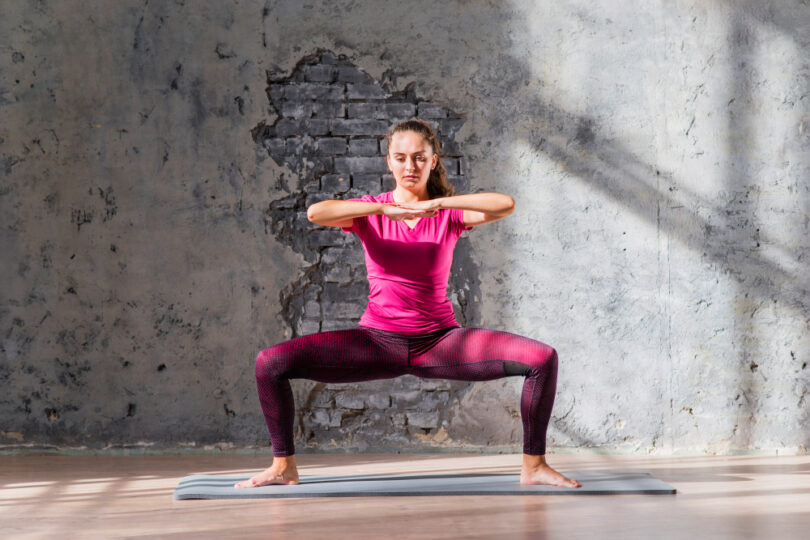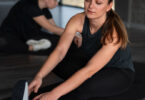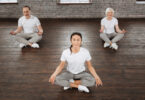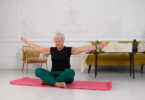Yoga has been practiced for centuries to improve physical and mental well-being. It offers many benefits, from increased flexibility and strength to stress relief and improved posture. One key component of a successful yoga practice is the selection of appropriate poses. This article will explore some of the best yoga poses to help you achieve optimal results.
Table of Contents
Introduction
Yoga Poses is not just a form of exercise; it’s a way of life. By practicing yoga regularly, you can experience a profound transformation in your body and mind. Some poses can benefit whether you’re a beginner or an experienced yogi.
Importance of Yoga Poses
Yoga poses, or asanas, are physical postures that help stretch, strengthen, and balance the body. Each pose has unique benefits, and when practiced together, they create a holistic approach to health and wellness.
Best Yoga Poses for Beginners
For beginners, it’s essential to start with simple yoga poses that focus on building strength, flexibility, and balance. Here are some of the best yoga poses for beginners:
- Mountain Pose (Tadasana): Stand tall with feet hip-width apart, arms at your sides, and shoulders relaxed. This pose improves posture and balance.
- Child’s Pose (Balasana): Kneel on the floor, touch your big toes together, sit on your heels, and lower your torso between your knees. Extend your arms in front or alongside your body. This pose is excellent for relaxation and stretching the back.
- Cat-Cow Stretch (Chakravakasana): Start on your hands and knees, with your wrists directly under your shoulders and your knees under your hips. Inhale as you arch your back and lift your head and tailbone (Cow Pose), then exhale as you round your back toward the ceiling and tuck your chin to your chest (Cat Pose). This pose improves spine flexibility.
- Downward-Facing Dog (Adho Mukha Svanasana): From the hands and knees position, lift your hips up and back, straightening your arms and legs to form an upside-down “V” shape. This pose stretches the entire body, especially the back, hamstrings, and calves.
- Warrior I (Virabhadrasana I): Start in a lunge position with your right foot forward. Turn your left foot to a 45-degree angle and square your hips to the front. Raise your arms overhead, palms facing each other. Hold for a few breaths and switch sides. This pose strengthens the legs and opens the chest and shoulders.
- Bridge Pose (Setu Bandhasana): Lie on your back with your knees bent and feet flat on the floor. Press your feet into the floor, lift your hips, and interlace your fingers beneath your back, pressing your arms into the mat. This pose strengthens the back, buttocks, and hamstrings.
- Corpse Pose (Savasana): Lie flat on your back with your arms and legs comfortably spread. Close your eyes and relax, focusing on your breath. This pose is for relaxation and helps reduce stress and anxiety.
These poses can be a great starting point for beginners, but listening to your body and not pushing yourself too hard is essential. Always consult a yoga instructor if you have any concerns or health conditions.
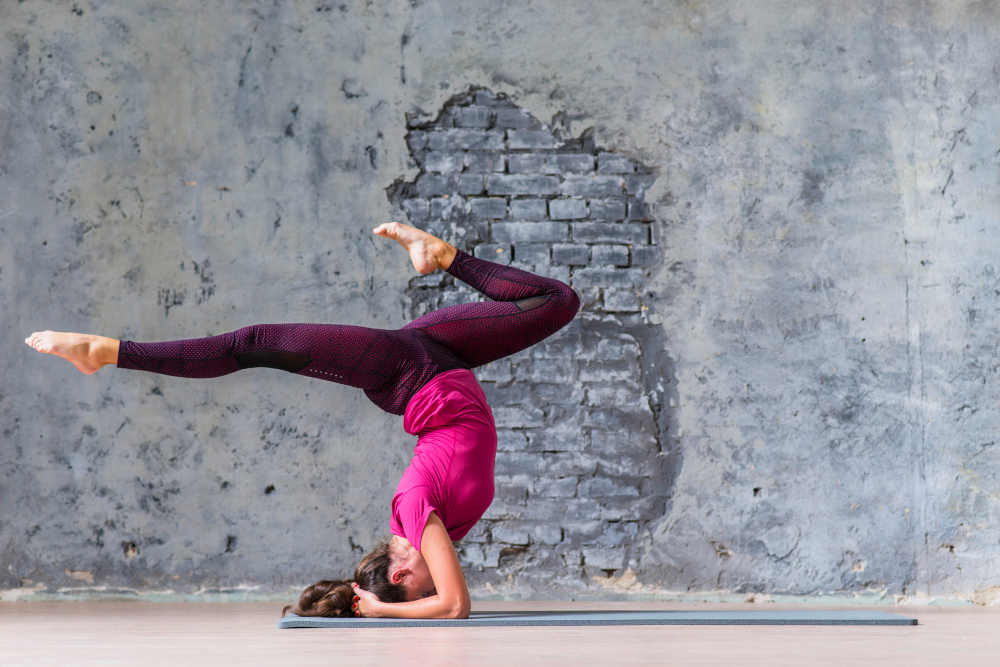
Intermediate Yoga Poses
For those looking to progress beyond the basics, intermediate yoga poses offer a chance to deepen your practice and challenge your body and mind. Here are some intermediate yoga poses to explore:
- Boat Pose (Navasana): Sit on the floor with your legs extended in front of you. Lean back slightly and lift your legs, keeping them straight so your body forms a V shape. Extend your arms parallel to the floor. This pose strengthens the core and hip flexors.
- Chair Pose (Utkatasana): Stand with your feet together, bend your knees, and lower your hips as if sitting in a chair. Raise your arms overhead, palms facing each other. Keep your weight in your heels and chest lifted. This pose strengthens the thighs and back while improving balance.
- Plank Pose (Phalakasana): Lower your forearms to the mat from a push-up position with your elbows directly under your shoulders. Keep your body straight from head to heels, engaging your core and leg muscles. Hold for several breaths. This pose strengthens the core, arms, and shoulders.
- Upward-Facing Dog (Urdhva Mukha Svanasana): Start lying face down on the mat with your hands under your shoulders. Press into your hands and lift your chest off the mat, keeping your legs extended and the tops of the feet pressing into the mat. This pose stretches the chest and strengthens the arms, shoulders, and back.
- Revolved Triangle Pose (Parivrtta Trikonasana): Start standing, then step back about 3-4 feet and turn your left foot out to a 45-degree angle. Square your hips to the front and extend your arms to the sides. Reach your right hand down to the floor (or a block) beside your right foot and extend your left arm toward the ceiling, twisting your torso. This pose stretches the hamstrings and hips while improving balance and core strength.
- Camel Pose (Ustrasana): Kneel on the floor with your knees hip-width apart. Place your hands on your lower back, fingers pointing down. Lean back, pressing your hips forward and arching your back. Reach your hands back to grasp your heels if comfortable. This pose stretches the front of the body, including the chest, abdomen, and quadriceps.
- Half Moon Pose (Ardha Chandrasana): From standing, shift your weight onto your right foot and lift your left foot off the mat. Extend your left leg back and parallel to the floor while extending your left arm toward the ceiling. Keep your right hand on the floor or a block for support. This pose improves balance and strengthens the legs, core, and ankles.
Related Article: Chair Yoga Workout: A Holistic Approach to Wellness
Advanced Yoga Poses
Advanced yoga poses require a strong foundation and consistent practice. They often combine strength, flexibility, balance, and concentration. Here are some challenging advanced yoga poses to explore:
- Firefly Pose (Tittibhasana): Start squatting with your feet slightly wider than hip-width apart. Place your hands on the floor in front of you, shoulder-width apart. Lean forward, lift your hips, and bring your knees to the backs of your upper arms. Slowly straighten your arms and lift your feet off the floor, extending your legs parallel to the floor. This pose strengthens the arms, wrists, and core.
- Peacock Pose (Mayurasana): Kneel on the floor and place your hands on the floor, fingers pointing toward your body. Lean forward, bend your elbows, and put them into your abdomen. Lift your legs one at a time off the floor until they are parallel. This pose strengthens the arms, wrists, and core.
- Scorpion Pose (Vrischikasana): Begin in a forearm plank position. Slowly walk your feet toward your elbows, lifting your hips and arching your back. Allow your head to hang freely, or touch the top of your head to the floor. This pose requires significant flexibility in the spine and shoulders.
- Flying Pigeon Pose (Eka Pada Galavasana): Start with your right foot forward in a low lunge. Place your hands on the floor on either side of your right foot. Shift your weight forward, bend your elbows, and place your right ankle on your left thigh. Extend your left leg back and lift your chest. Lean forward and lift your hands off the floor if possible. This pose requires strength, balance, and hip flexibility.
- Wheel Pose (Urdhva Dhanurasana): Lie on your back with your knees bent and feet flat on the floor, hip-width apart. Place your hands on the floor beside your head, fingertips pointing toward your shoulders. Press into your hands and feet, lifting your hips toward the ceiling. Straighten your arms and legs as much as possible, opening your chest. This pose strengthens the back, arms, and legs while improving flexibility in the spine and shoulders.
- Eight-Angle Pose (Astavakrasana): Sit on the floor with your legs extended. Bend your knees and place your feet on the floor, hip-width apart. Place your hands on the floor beside your hips, fingers pointing forward. Lift your hips and shift your weight onto your hands. Bend your elbows and lean forward, placing your right ankle on your left thigh. Shift your weight to your hands and cross your left ankle over your right, hooking your left foot behind your right calf. This pose requires arm strength, hip flexibility, and core stability.
- Feathered Peacock Pose (Pincha Mayurasana): Start in a forearm plank position with your forearms on the mat, elbows shoulder-width apart. Walk your feet toward your elbows as close as possible. Lift one leg off the floor and then the other, coming into a forearm stand. This pose strengthens the arms, shoulders, and core and improves balance.
These advanced poses should be practiced under the guidance of a qualified yoga instructor, especially if you’re new to them. Listen to your body; don’t force yourself into a pose if it feels painful or uncomfortable.
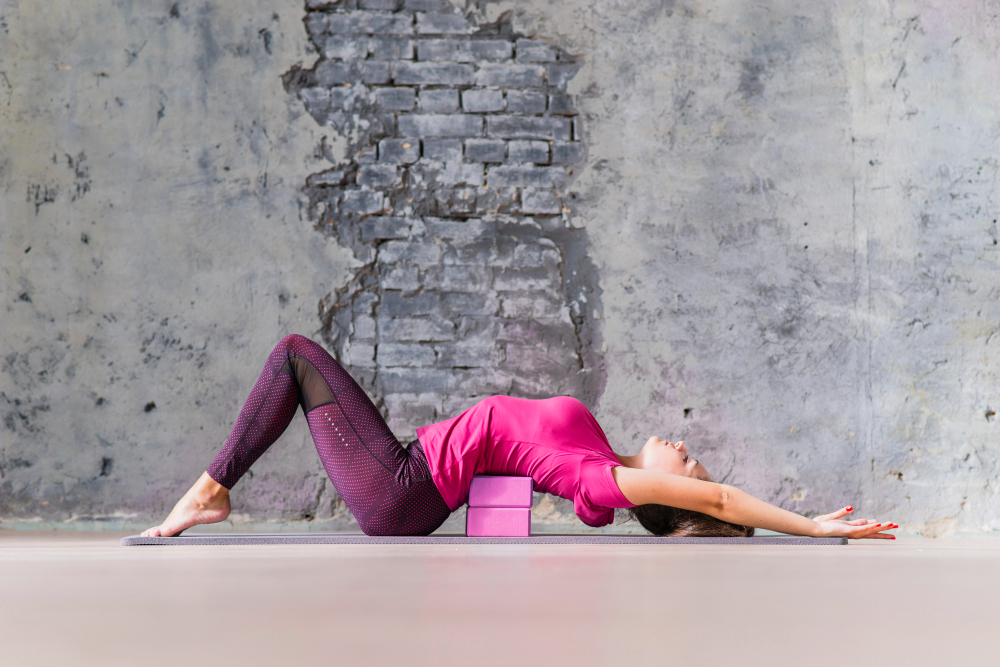
Yoga Poses for Stress Relief
Yoga can be incredibly effective for relieving stress and promoting relaxation. Here are some yoga poses that are particularly beneficial for stress relief:
- Child’s Pose (Balasana): Kneel on the floor, touch your big toes together, sit on your heels, and lower your torso between your knees. Extend your arms in front or alongside your body. This pose helps to calm the mind and relieve tension in the back and shoulders.
- Forward Fold (Uttanasana): Stand tall with your feet hip-width apart, exhale as you bend forward from the hips, bringing your hands to the floor or grabbing onto your elbows. Relax your head and neck. This pose releases back, hamstrings, and neck tension and can help calm the mind.
- Legs Up the Wall Pose (Viparita Karani): Sit close to a wall and lie on your back, swinging your legs up the wall. Your hips should be touching or very close to the wall. Relax your arms by your sides, palms facing up. This pose is deeply relaxing and can help reduce anxiety and insomnia.
- Corpse Pose (Savasana): Lie flat on your back with your arms and legs comfortably spread. Close your eyes and relax, focusing on your breath. This pose is excellent for relaxation and reducing stress and anxiety.
- Seated Forward Bend (Paschimottanasana): Sit on the floor with your legs extended. Inhale as you lengthen your spine, then exhale as you bend forward from the hips, reaching for your feet or ankles. Keep your spine long and relax your neck. This pose calms the mind and stretches the spine and hamstrings.
- Cat-Cow Stretch (Chakravakasana): Start on your hands and knees, with your wrists directly under your shoulders and your knees under your hips. Inhale as you arch your back and lift your head and tailbone (Cow Pose), then exhale as you round your back toward the ceiling and tuck your chin to your chest (Cat Pose). This pose helps to relieve stress and tension in the spine.
- Bridge Pose (Setu Bandhasana): Lie on your back with your knees bent and feet flat on the floor. Press your feet into the floor, lift your hips, and interlace your fingers beneath your back, pressing your arms into the mat. This pose stretches the chest, neck, and spine and can help alleviate stress and mild depression.
Related Article: Yoga Workout Class For Lower Body
Yoga Poses for Flexibility
Improving flexibility is one of the many benefits of a regular yoga practice. Here are some yoga poses that can help increase flexibility:
- Forward Fold (Uttanasana): Stand tall with your feet hip-width apart, exhale as you bend forward from the hips, bringing your hands to the floor or grabbing onto your elbows. Relax your head and neck. This pose stretches the hamstrings, calves, and lower back.
- Downward-Facing Dog (Adho Mukha Svanasana): From a hands-and-knees position, lift your hips up and back, straightening your arms and legs to form an upside-down “V” shape. Press your heels toward the floor to stretch the calves and hamstrings.
- Cobra Pose (Bhujangasana): Lie on your stomach with your hands under your shoulders. Inhale as you lift your chest off the mat, keeping your elbows close to your sides. Press the tops of your feet into the floor to stretch the front of your body, including the abdomen and hip flexors.
- Cow-face pose (Gomukhasana): Sit with your legs extended before you. Bend your knees and stack your right knee on your left, bringing your feet to either side of your hips. Inhale as you reach your right arm overhead and bend your elbow, placing your right hand between your shoulder blades. Reach your left arm behind your back and try to clasp your hands. This pose stretches the hips, thighs, shoulders, and triceps.
- Pigeon Pose (Eka Pada Rajakapotasana): From a hands-and-knees position, bring your right knee forward and place it behind your right wrist. Extend your left leg back and lower your hips toward the floor. Keep your back leg straight and your toes pointed. This pose stretches the hip flexors, thighs, and glutes.
- Seated Forward Bend (Paschimottanasana): Sit on the floor with your legs extended. Inhale as you lengthen your spine, then exhale as you bend forward from the hips, reaching for your feet or ankles. Keep your spine long and relax your neck. This pose stretches the spine, hamstrings, and calves.
- Butterfly Pose (Baddha Konasana): Sit on the floor with your knees bent and feet together. Hold onto your feet or ankles and gently press your knees toward the floor. This pose stretches the inner thighs and groins.
These poses can be practiced regularly to improve flexibility over time. It’s essential to listen to your body and not push yourself too hard, especially if you’re new to yoga or have injuries.
Conclusion
In conclusion, regular yoga poses can lead to many benefits, including improved flexibility, strength, and mental clarity. By incorporating these best yoga poses into your routine, you can achieve optimal results and live a healthier, more balanced life.

